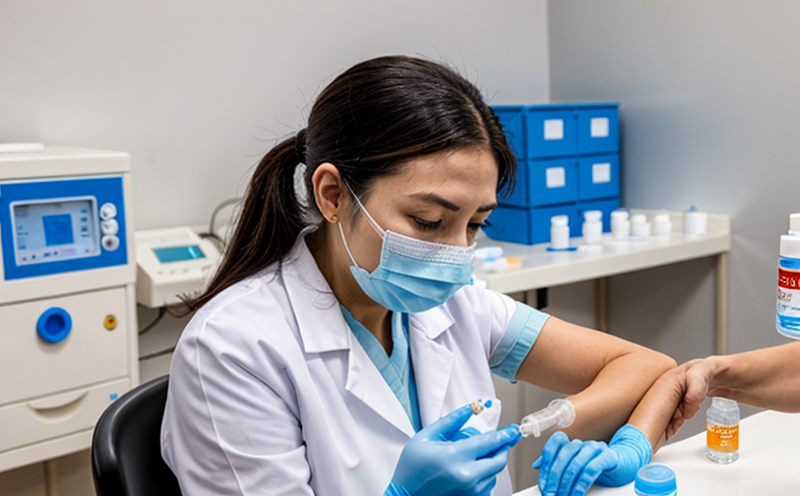WHO Potency Testing of Influenza Vaccine
The World Health Organization (WHO) potency testing is a critical step in ensuring the efficacy and safety of influenza vaccines. This standardized procedure aims to measure the concentration of antigenic components, which directly impacts the vaccine's ability to elicit an immune response against specific strains of influenza virus. The process involves intricate laboratory techniques that comply with international standards such as WHO guidelines, ASTM E2583, and ISO 17025.
WHO potency testing is a multi-step procedure that begins with the isolation of influenza viruses from culture fluids or tissues. These isolates are then used to produce monovalent or multivalent vaccines. The process ensures uniformity in vaccine composition across different lots and batches, which is crucial for public health safety and regulatory compliance.
The testing involves several key steps:
- Isolation of the influenza virus from culture fluids or tissues
- Cultivation of virus stocks to ensure sufficient quantities
- Dilution series preparation to cover a range of concentrations
- Incubation and neutralization using appropriate antisera
- Measurement of hemagglutination inhibition (HI) titers
The results are then used to determine the actual concentration of antigen present in each dose, ensuring that the vaccine meets WHO potency specifications. This process is essential for maintaining high standards of quality and consistency in influenza vaccines.
Given the variability in viral strains and the need for continuous updates to the influenza vaccine composition, WHO potency testing plays a pivotal role in the development and production of effective vaccines. Compliance with these rigorous tests ensures that healthcare providers can confidently recommend and administer safe and efficacious vaccines to the public.
The importance of this testing cannot be overstated, as it directly influences patient outcomes by ensuring that the administered vaccine is potent enough to provide robust immunity against influenza strains. This service is particularly critical for organizations involved in pharmaceutical research and development, quality assurance, and compliance management.
Industry Applications
Influenza vaccines are crucial components of public health strategies worldwide. The WHO potency testing ensures that these vaccines meet international standards and provide the expected level of protection against influenza. This service is particularly valuable for:
- Vaccine Manufacturers: Ensuring compliance with WHO recommendations and regulatory requirements.
- Healthcare Providers: Guaranteeing that the vaccines they administer are potent and effective.
- Regulatory Authorities: Verifying that vaccine batches meet specified potency levels before market approval.
The results of WHO potency testing provide critical data for vaccine manufacturers to refine production processes, optimize antigen concentrations, and improve overall vaccine efficacy. For healthcare providers, this ensures they are administering vaccines that have been rigorously tested and approved by international standards.
Regulatory authorities rely on these tests to ensure public health safety and compliance with international guidelines. The WHO potency testing is a cornerstone of the global effort to combat influenza effectively and efficiently.
Quality and Reliability Assurance
The quality and reliability of influenza vaccines are paramount for maintaining public trust in immunization programs. WHO potency testing ensures that each batch of vaccine meets stringent international standards, thereby enhancing patient safety and effectiveness.
The process begins with the selection of appropriate viral strains for inclusion in the vaccine formulation. This selection is based on surveillance data from global flu networks, which identify prevalent influenza strains. Once selected, these strains are propagated in suitable cell cultures or eggs to generate sufficient quantities for testing.
The potency test involves a series of steps designed to assess the concentration and purity of antigenic components:
- Antigen Preparation: Isolation and purification of viral antigens from culture fluids or tissues.
- Dilution Series: Preparation of multiple dilutions to cover a range of concentrations for testing.
- Hemagglutination Inhibition (HI) Titers: Measurement of the HI titer, which indicates the concentration of virus-neutralizing antibodies in the vaccine.
The final step involves calculating the potency based on the hemagglutination inhibition titers. This calculation ensures that each dose of the vaccine contains the specified amount of antigen necessary to induce a protective immune response.
By adhering to these rigorous standards, laboratories can provide reliable and consistent results that meet or exceed WHO specifications. This not only enhances public confidence in immunization programs but also supports international efforts to control influenza outbreaks effectively.
International Acceptance and Recognition
The World Health Organization (WHO) potency testing of influenza vaccines is recognized globally for its accuracy, reliability, and consistency. This service ensures that vaccine batches meet stringent international standards, thereby enhancing public health safety and compliance with regulatory requirements.
The WHO's Global Influenza Surveillance and Response System (GISRS) plays a crucial role in informing the composition of seasonal influenza vaccines. The GISRS network, comprising collaborating centers and national influenza centers worldwide, monitors circulating influenza viruses, identifies key strains, and recommends them for inclusion in vaccine formulations. This collaborative effort ensures that the vaccines are tailored to address current global threats effectively.
The potency testing process is meticulously standardized to ensure uniformity across different batches and production sites. Compliance with these rigorous tests guarantees that healthcare providers can confidently recommend and administer safe and efficacious vaccines to the public. Regulatory authorities, such as the FDA in the United States or EMA in Europe, rely on WHO potency test results to approve vaccine batches for market release.
The international acceptance of WHO potency testing is reflected in its widespread use by pharmaceutical companies, healthcare providers, and regulatory bodies worldwide. This global recognition underscores the importance of this service in maintaining high standards of quality and consistency in influenza vaccines.





